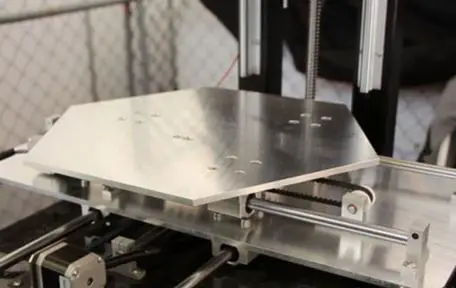3D printing is attracting a lot of attention lately, however many people still view it as more of a novelty or gimmick. This is most likely due to the fact that most low cost printers can only print with plastic. But what if you could print parts from metal at a reasonable cost? A new startup called Vader systems is aiming to just that–bring affordable metal printing systems into the commercial market.
Vader systems is the brain child of a father-and-son team – Scott and Zachary Vader. The company was set out to create a novel Liquid Metal Jet Printing device (LMJP) – a type of additive 3D printer which lays down tiny droplets of molten aluminum in order to create physical objects gradually, layer by layer (this is unlike subtractive 3D printing methods which start with a piece of material and take away parts until they reach the finished product).
Vader systems – 3D metal printer prototype
Vader’s technology is somewhat similar to consumer ink jet printers but instead of ink the print head shoots away the droplets of molten aluminum and make sure they are deposited layer on top of layer according to the specify product design.
3D printing with metal is nothing new. 3D printers based on Direct Metal Laser Sintering (DMLS) for example have been around for years and have been using laser to melt the metal powder to create 3D objects from all sorts of materials (including stainless steel, cobalt chromium and even titanium). One of the main drawbacks with DMLS is the cost of the 3D printers which have to include a very powerful laser – typically ranging over half a million dollars – only suitable for medium-large companies and manufacturers.
Being able to bring down the price of a 3D metal printer to a level where small businesses might be able to afford them is just the goal Vader systems set for itself. They are looking to create an LMJP that will cost between $10-$50k – less than 10’th the price of a DMLS device. They are currently working on a prototype with a goal of a Mark 1 commercial machine by mid 2014 (for mid-large organizations), a Mark 2 machine for wider commercial sales by end of 2014 and an even more ambitious low cost Mark 3 machine for small businesses, engineering firms and other professional makers by 2015 (maybe even lower than $10k per unit).
3D metal printing was actually in the news just last week when Solid Concepts – a series player in the 3D printing industry created the first ever 3D printed 1911 gun made of metal which fired 600+ rounds. On the press release and blog post the company published, it explained that it used a DMLS process to create 30 individual components for the gun from 17-4 Stainless Steel which has not been post heat treated (just to see how the least strong option will do before creating stronger one will). The gun functioned without a problem after extensive testing.
Solid Concepts did state that this type of project was only done to show what this technology can do and at present time there is no real risk that people will be able to come up
with full metal guns in their own back yards as the DMLS printer used for creating the gun is a very expensive piece of technology. Solid Concepts even printed a unique serial number on the gun as ATF requires (they mention that they are the only 3D printing company to have a gun manufacturing license in the U.S.).
But we ask what will happen in a few years when Vader systems and other low cost 3D metal printing technologies will reach the market? Will legislation be enough? Can you really prevent people from printing their own guns or even bombs? There doesn’t seem to be any clear and simple answer to these question at this time.
To see the evolution of 3d printing check out more articles here.













